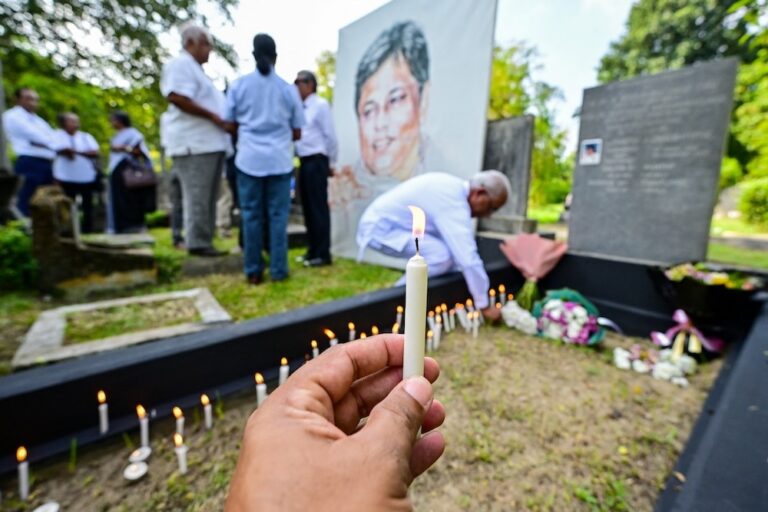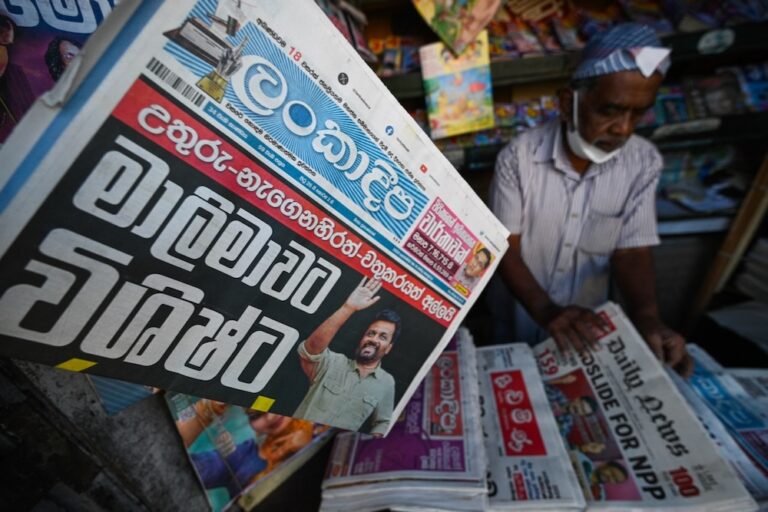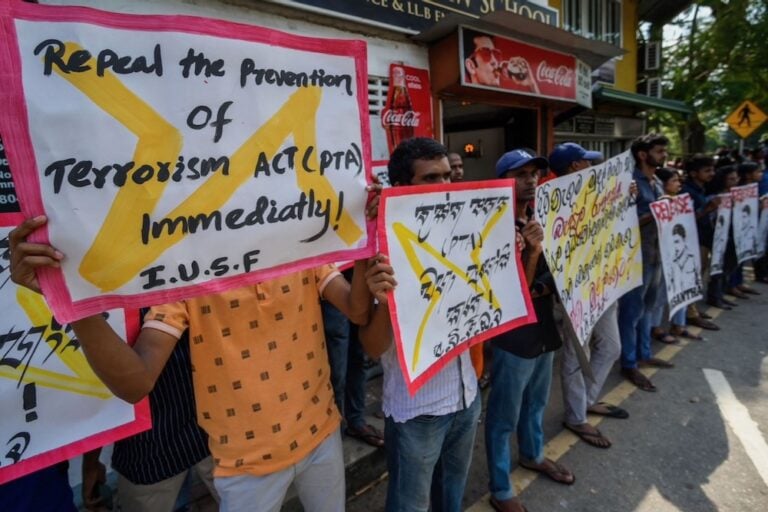(FMM/IFEX) – The following is a 24 December 2007 FMM press release: FMM deplores Sri Lankan Media Minister’s statement 24 December 2007, Colombo, Sri Lanka – The Free Media Movement (FMM) is strongly opposed to and deeply regrets the self-styled definition of “journalist” as put forward recently by the Sri Lankan Media Minister, Hon. Anura […]
(FMM/IFEX) – The following is a 24 December 2007 FMM press release:
FMM deplores Sri Lankan Media Minister’s statement
24 December 2007, Colombo, Sri Lanka – The Free Media Movement (FMM) is strongly opposed to and deeply regrets the self-styled definition of “journalist” as put forward recently by the Sri Lankan Media Minister, Hon. Anura Priyadarshana Yapa.
Responding to the Press Emblem Campaign (PEC) report that placed Sri Lanka as the third most dangerous country in the world for journalists to work in, the Minister averred that only those who have obtained media accreditation cards issued by the Government Information Department are considered journalists. He went on to say that, according to this criterion, only one journalist was killed in 2007.
The FMM strongly disagrees with, and is appalled by the inappropriateness of, this restrictive definition of what constitutes a journalist. In keeping with globally accepted norms and standards of journalism today, the FMM instead believes that anyone who – as a professional activity – engages in gathering, editing and disseminating information, individually or organizationally, in an impartial, accurate and professional manner, is a journalist. This includes bloggers and citizens who create, edit or otherwise disseminate content on the Internet dealing with socio-political and cultural issues, including content on governance, democracy and fundamental rights. This understanding of traditional and new forms of journalism is the norm in democratic societies today, following principles of media freedom and freedom of expression.
Killing or verbally or physically harming anyone who fits this definition constitutes an action against a journalist and the media community. Accordingly, the FMM is compelled to firmly assert that the Media Minister’s own definition is woefully outmoded and dangerously partial to the government’s concerted efforts to down play and gloss over its own egregious responsibility in severely undermining the security and safety of journalists in Sri Lanka.
– On 15 February 2007, journalist Subramaniam Ramachandran went missing. According to the information collected by the International Mission of Press Freedom and the Freedom of Expression in July this year, Ramachandran left the class he ran in Karaveddy in the early evening with a friend. Soldiers stopped them for questioning when they got as far as the Kalikai Junction military camp. His friend was allowed to leave and Ramachandran was detained. His family has since had no news of him and he is feared dead.
– On 16 April 2007 Subash Chandraboas (32), who edited his own monthly literary magazine, was shot dead at about 7:30 p.m. at his residence in Thirunavatkulam, Vavuniya. He was a former student of the Sri Lanka College of Journalism and had also obtained a month’s training from the “Virakesari” newspaper. He had served with the London-based magazine “Tamil World” as a freelance journalist. Mr. Chandraboas owned a small printing press in Vavuniya and was known for his passion for literature.
– On 29 April 2007, Selvarajah Rajivarnam was shot dead as he was cycling to his office in Jaffna Town. Rajivarnam, 24, had worked at the newspaper for six months covering crime stories and visiting police stations and hospitals to investigate disappearances. He had worked for three years on “Namathu Eelanadu”, whose managing director was killed in August 2006.
– On 1 August 2007 Sahathevan Nilakshan, a journalism student who edited the “Chaalaram” magazine, was shot dead in Kokuvil, Jaffna. He used to report for media outlets of the Tamil diaspora as well.
None of the above victims were in possession of media accreditation cards issued by the Media Ministry for 2007.
What is more, despite strong local and international condemnation, including from the offices of the International Federation of Journalists (IFJ) and UNESCO, the government obstinately continues to not accept that their targeting of the Voice of Tigers (VOT) radio station on 27 November 2007 was an attack against journalists. The attack killed 11 civilians and among them were one journalist (Isaivizhi Chempiyan alias Subajini) and two media workers of VOT (Suresh Linbiyo and T. Tharmalingam).
Two more media workers, Anthonypillai Sherin Sithranjan and Vadivel Nimalarajah, were abducted in November 2007 in Jaffna.
The Sri Lankan Media Minister’s denial of these acts of violence against the media community will strengthen the existing culture of impunity and will not in any way help to identify and punish those responsible. On the other hand, while quick to denounce the PEC report, the Minister is tellingly silent on the attacks on the “Standard” newspapers and Leader publications, the closure of the ABC radio network, the unending harassment of Tamil media and journalists, threats to editors, government-sponsored hate speech campaigns against senior journalist Iqbal Athas, continuing threats against and intimidation of provincial correspondents, unofficial censorship, the increasing partiality and political bias of state controlled media, as well as inability to ensure legal frame work for freedom of expression in Sri Lanka. His silence on all these matters is a damning and undeniable indicator of his government’s inability and unwillingness to address the severe deterioration of media freedom in Sri Lanka.


